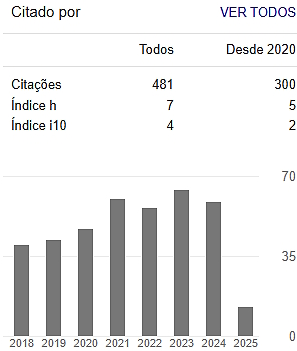CONTROLE DE CAOS NO MODELO NEURONAL DE HINDMARSH-ROSE COM PARÂMETROS INCERTOS
Palavras-chave:
Caos, Parâmetros Incertos, Controle ÓtimoResumo
Na bioengenharia existe uma grande motivação no estudo do modelo neuronal de Hindmarsh-Rose (HR) pelo fato de ser bem representativo ao neurônio biológico podendo, assim, simular vários comportamentos de um neurônio real, dentre eles, o comportamento periódico, aperiódico e caótico. Baseado neste modelo, este artigo propõe a aplicação do projeto de controle linear ótimo ao comportamento incerto e caótico estabelecidos por modificações nos parâmetros do sistema. Para tanto, apresenta-se o sistema matemático do modelo RH e seu comportamento caótico e posteriormente modificam-se os parâmetros fixos para incertos e investiga-se a dinâmica caótica do sistema. Finalizando, propõe-se a aplicação do controle linear ótimo como método para controlar o comportamento caótico do modelo onde as simulações numéricas são apresentadas para demonstrar a eficácia desta proposta.
Downloads
Referências
BEAR, M. F., CONNORS, B. W., PARADISO, M. A. Neurociências: desvendando o sistema nervoso. Artmed Editora, 2002.
BUTERA Jr, R. J., RINZEL, J., SMITH, J. C. Models of respiratory rhythm generation in the pre-Botzinger complex. I. Bursting pacemaker neurons. Journal of neurophysiol ogy, v. 82, n. 1, p. 382-397, 1999.
https://doi.org/10.1152/jn.1999.82.1.382.
CHAVARETTE, F. R. Optimal linear control to parametric uncertainties in a micro electro mechanical system. International Journal of Pure and Applied Mathematics, v. 83, n. 4, p. 539-548, 2013.
https://doi.org/10.12732/ijpam.v83i4.2.
CLOUTIER, J. R.; D'SOUZA, CHRISTOPHER N.; MRACEK, CURTIS P. Nonlinear regulation and nonlinear H∞ control via the state-dependent Riccati equation technique: Part 1, theory. In: Proceedings of the international conference on nonlinear problems in aviation and aerospace. Embry Riddle University, 1996. p. 117-131.
CVETICĆANIN, L. Dynamics of the non-ideal mechanical systems: A review. Journal of the Serbian Society for Computational Mechanics, v. 4, n. 2, p. 75-86, 2010.
DE LIMA, R. S., CHAVARETTE, F. R., ROÉFERO, L. G. P. Estudo do Comportamento Dinâmico do Modelo Neuronal de Hindmarsh-Rose. In: Colloquium Exactarum. ISSN: 2178-8332. 2019. p. 122-130.
http://journal.unoeste.br/index.php/ce/article/view/3283/2889. https://doi.org/10.5747/ce.2019.v11.n4.e301
GHANEM, R. G., SPANOS, POL D. Stochastic finite elements: a spectral approach. Courier Corporation, 2003.
HAMI, A. E., RADI, B. Uncertainty and Optimization in Structural Mechanics. John Wiley & Sons, 2013.
HINDMARSH, J. L., ROSE, R. M. A model of neuronal bursting using three coupled first order differential equations. Proceedings of the Royal society of London. Series B. Biological sciences, v. 221, n. 1222, p. 87-102, 1984.
https://doi.org/10.1098/rspb.1984.0024.
HODGKIN, A. L., HUXLEY, A. F. A quantitative description of membrane current and its application to conduction and excitation in nerve. The Journal of physiology}, v. 117, n. 4, p. 500-544, 1952. https://doi.org/10.1113/jphysiol.1952.sp004764.
JUN, M. et al. Control Chaos in Hindmarsh—Rose Neuron by Using Intermittent Feedback with One Variable. Chinese Physics Letters, v. 25, n. 10, p. 3582, 2008. https://doi.org/10.1088/0256-307X/25/10/017
LARA-MOLINA, F. A., ROSARIO, J. M., Dumur, D., Wenger, P. Generalized predictive control of parallel robots. In: Koz lowski, K. (Ed.), Robot Motion and Control 2011. Springer London, volume 422 de Lecture Notes in Control and Information Sciences, pages 159-169, 2012. https://doi.org/10.1007/978-1-4471-2343-9_13
LORENZ, E. N. Section of planetary sciences: The predictability of hydrodynamic flow* . Transactions of the New York Academy of Sciences, v. 25, n. 4 Series II, p. 409-432, 1963. https://doi.org/10.1111/j.2164-0947.1963.tb01464.x.
MOLLER, B., BEER, M. Fuzzy Randomness, Uncertainty in Civil Engineering and Computational Mechanics. Springer-Verlag, 2004. https://doi.org/10.1007/978-3-662-07358-2
MONTEIRO, L. H. A. Sistemas dinâmicos. Editora Livraria da Física, 2002.
MRACEK, C. P., CLONTIER, J. R., D'Sousa, Christopher, A. A new technique for nonlinear estimation. In: Proceeding of the 1996 IEEE International Conference on Control Applications IEEE International Conference on Control Applications held together with IEEE International Symposium on Intelligent Contro}. IEEE, 1996. p. 338-343.
https://doi.org/10.1109/CCA.1996.558760.
PALUS, MILAN et al. Synchronization and information flow in EEGs of epileptic patients. IEEE Engineering in Medicine and Biology Magazine, v. 20, n. 5, p. 65-71, 2001. https://doi.org/10.1109/51.956821.
PEARSON, J. D. Approximation methods in optimal control I. Sub-optimal control. International Journal of Electronics, v. 13, n. 5, p. 453-469, 1962.
https://doi.org/10.1080/00207216208937454.
SHAWKY, A. M. et al. Position control of flexible manipulator using non-linear H with state-dependent Riccati equation. Proceedings of the Institution of Mechanical Engineers, Part I: Journal of Systems and Control Engineering, v. 221, n. 3, p. 475-486, 2007.
https://doi.org/10.1243/09596518JSCE313.
VICENTE, J. P. G., CHAVARETTE, F. R., ROÉFERO, L. G. P. Chaos Control via Mathieu-Van der Pol System and Linear Optimal Control Design with a Non-ideal Excitation and Parametric Uncertainties. Revista Internacional de Metodos Numericos para Calculo y Diseno en Ingenieria, v. 35, p. 37-47, 2019.
http://dx.doi.org/10.23967/j.rimni.2019.08.001.
WERNELI, A., COOK, G. Suboptimal control for the nonlinear quadratic regulator problem. Automatica, v. 11, n. 1, p. 75-84, 1975. https://doi.org/10.1016/0005-1098(75)90010-2.
WOLF, A. et al. Determining Lyapunov exponents from a time series. Physica D: Nonlinear Phenomena, v. 16, n. 3, p. 285-317, 1985. https://www.sciencedirect.com/science/article/abs/pii/0167278985900119.

